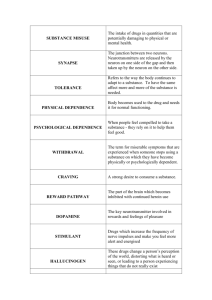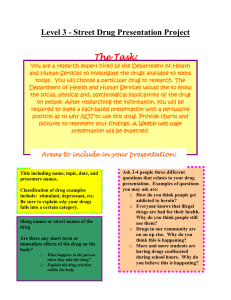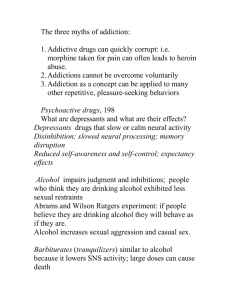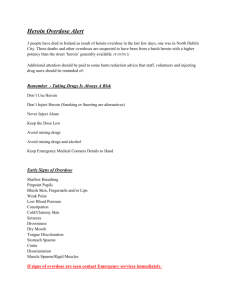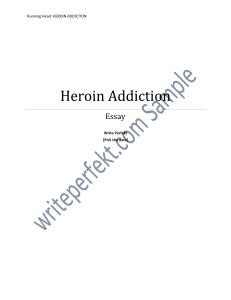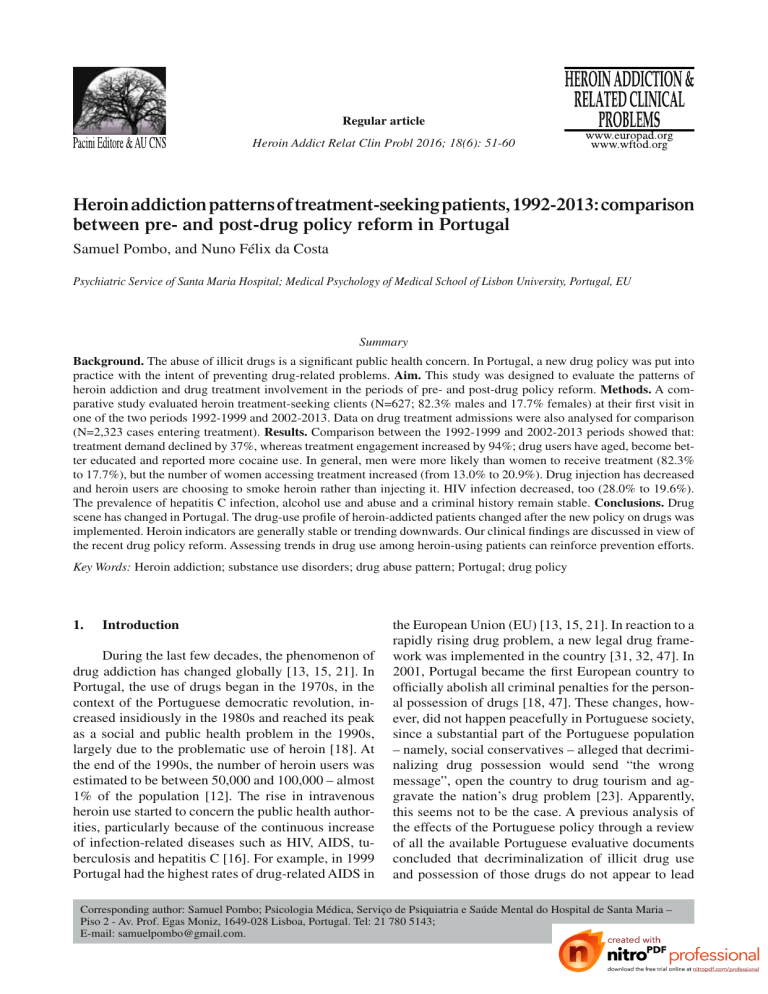
Regular article Heroin Addict Relat Clin Probl 2016; 18(6): 51-60 Heroin addiction patterns of treatment-seeking patients, 1992-2013: comparison between pre- and post-drug policy reform in Portugal Samuel Pombo, and Nuno Félix da Costa Psychiatric Service of Santa Maria Hospital; Medical Psychology of Medical School of Lisbon University, Portugal, EU Summary Background. The abuse of illicit drugs is a significant public health concern. In Portugal, a new drug policy was put into practice with the intent of preventing drug-related problems. Aim. This study was designed to evaluate the patterns of heroin addiction and drug treatment involvement in the periods of pre- and post-drug policy reform. Methods. A comparative study evaluated heroin treatment-seeking clients (N=627; 82.3% males and 17.7% females) at their first visit in one of the two periods 1992-1999 and 2002-2013. Data on drug treatment admissions were also analysed for comparison (N=2,323 cases entering treatment). Results. Comparison between the 1992-1999 and 2002-2013 periods showed that: treatment demand declined by 37%, whereas treatment engagement increased by 94%; drug users have aged, become better educated and reported more cocaine use. In general, men were more likely than women to receive treatment (82.3% to 17.7%), but the number of women accessing treatment increased (from 13.0% to 20.9%). Drug injection has decreased and heroin users are choosing to smoke heroin rather than injecting it. HIV infection decreased, too (28.0% to 19.6%). The prevalence of hepatitis C infection, alcohol use and abuse and a criminal history remain stable. Conclusions. Drug scene has changed in Portugal. The drug-use profile of heroin-addicted patients changed after the new policy on drugs was implemented. Heroin indicators are generally stable or trending downwards. Our clinical findings are discussed in view of the recent drug policy reform. Assessing trends in drug use among heroin-using patients can reinforce prevention efforts. Key Words: Heroin addiction; substance use disorders; drug abuse pattern; Portugal; drug policy 1. Introduction During the last few decades, the phenomenon of drug addiction has changed globally [13, 15, 21]. In Portugal, the use of drugs began in the 1970s, in the context of the Portuguese democratic revolution, increased insidiously in the 1980s and reached its peak as a social and public health problem in the 1990s, largely due to the problematic use of heroin [18]. At the end of the 1990s, the number of heroin users was estimated to be between 50,000 and 100,000 – almost 1% of the population [12]. The rise in intravenous heroin use started to concern the public health authorities, particularly because of the continuous increase of infection-related diseases such as HIV, AIDS, tuberculosis and hepatitis C [16]. For example, in 1999 Portugal had the highest rates of drug-related AIDS in the European Union (EU) [13, 15, 21]. In reaction to a rapidly rising drug problem, a new legal drug framework was implemented in the country [31, 32, 47]. In 2001, Portugal became the first European country to officially abolish all criminal penalties for the personal possession of drugs [18, 47]. These changes, however, did not happen peacefully in Portuguese society, since a substantial part of the Portuguese population – namely, social conservatives – alleged that decriminalizing drug possession would send “the wrong message”, open the country to drug tourism and aggravate the nation’s drug problem [23]. Apparently, this seems not to be the case. A previous analysis of the effects of the Portuguese policy through a review of all the available Portuguese evaluative documents concluded that decriminalization of illicit drug use and possession of those drugs do not appear to lead Corresponding author: Samuel Pombo; Psicologia Médica, Serviço de Psiquiatria e Saúde Mental do Hospital de Santa Maria – Piso 2 - Av. Prof. Egas Moniz, 1649-028 Lisboa, Portugal. Tel: 21 780 5143; E-mail: samuelpombo@gmail.com. 51 Heroin Addiction and Related Clinical Problems 18(6): 51-60 automatically to an increase in drug-related problems and that there are no signs of a mass expansion of the drug market in Portugal [18]. Even though a causal effect between strategic efforts and social and health outcomes cannot be firmly established [30], there are some statistical indicators that suggest a promising correlation. For instance, the levels of illicit drug use in Portugal remain below the EU average [17], illegal drug use among teens has declined [4, 31], rates of new HIV infections caused by the sharing of dirty needles has dropped [31] and the number of people seeking treatment for drug addiction has more than doubled [30, 47]. Based on data concerning drug-related trends in Portugal both pre- and post-decriminalization, Glenn Greenwald [23] published a comprehensive case report recognizing “the success of drug decriminalization in Portugal”, so causing a major impact on the media and increasing public debate. More than ten years later, these changes continue to attract support and criticism. For instance, some authors are sceptical about the changes in heroin use and deaths in a small country like Portugal, suggesting that, due to the cyclical nature of drug epidemics, drug use and related problems might naturally decline no matter which policies are in place [11, 24, 45, 49]. Although several reports have demonstrated that heroin-related problems are declining, the true effects of Portuguese decriminalization can only be understood by comparing post-decriminalization usage and trends in Portugal with other European countries, as well as with non-European countries (such as the United States, Canada, and Australia) that continue to criminalize drugs even for personal usage [23]. For instance, over the last decade, European countries have made changes to their penalties for the possession of drugs. Three broad types of penalty changes can be identified: those changing the legal status of the offence (criminal or non-criminal); those changing categories of drugs, when the category determines the penalty; and those changing the size of the maximum penalty applicable. Most of the countries that have altered their penalties for possession have used a combination of these types of change, complicating the task of writing a concise analysis. Motives for change vary between countries. For example, laws have been changed to access addicts (Portugal), to simplify punishment (Belgium, Finland, United Kingdom in 2004), to harmonize misdemeanour penalties (Estonia, Slovenia) and to indicate levels of harm (Bulgaria, Czech Republic, France, Italy, Luxembourg, Romania, United Kingdom in 2009) [19]. However, - 52 - by and large, usage rates for each category of drugs continue to be lower in the European than in non-European countries, which have a far more criminalized approach to drug usage [8]. In sum, until the present, the interpretation of evidence on the Portuguese decriminalization of illicit drugs has continued to be a subject under discussion [26, 32]. In this regard, conducting a before-and-after empirical study taking into account the considerable changes that were made in this country could provide accurate information on heroin addiction trends in Portugal. Besides the epidemiological reports of drug use in the Portuguese general population [4], we can examine trends and the impact of the Portuguese policy regarding an important sub-population such as problematic heroin users. Moreover, heroin trends need to be monitored actively and continuously, as past experience has shown that drug problems often come in epidemic waves, with new generations being exposed to risk, especially when they have limited knowledge and experience of the serious problems that the use of heroin can cause [5, 20]. In response, and in order to comprehend the clinical profile of drug users obtained after many years of heroin addiction treatment, we examined the patterns of drug addiction and drug treatment involvement among individuals who applied for treatment in our addiction unit between 1992 and 2013. It was hypothesized that heroin-addicted patients that were admitted in the period prior to drug policy reform would present a more severe addiction history, when compared with those who were admitted in the subsequent period. 2. Methods Correlational and comparative methods were used to assess the study hypothesis. Retrospective data were collected during the period 1992 to 2013 from the Addiction Unit of the Mental Health and Psychiatric Service of Santa Maria University Hospital in Lisbon – to our knowledge, the first clinical structure to address the problem of drug addiction in Portugal (created in 1973). All patients were taken from the therapeutic programme centre and inclusion depended on meeting the criterion of a ‘primary’ diagnosis of heroin dependence. In DSM the “primary” drug is defined as the drug that causes the patient the most problems at the start of treatment. This is usually based on the request made by patients and/or on the diagnosis made by a therapist (commonly using standard instruments such as the Diagnostic and Statistical Manual of Men- S. Pombo & N. F. da Costa: Heroin addiction patterns of treatment-seeking patients, 1992-2013: comparison between pre- and post-drug policy reform in Portugal tal Disorders - DSM) [2, 20]. The standardized outpatient treatment protocol, generally based on a contingency management programme, combines a pharmacological and a psychosocial intervention. In pharmacological terms, the addiction unit offers a methadone/buprenorphine maintenance treatment programme as the treatment of choice for people who are heroin-dependent. The main psychological treatment modality is group psychotherapy (weekly; 1 to 2 hours) [42, 44]. In order to evaluate treatment-seeking we assessed the absolute numbers of patients in treatment from 1992 to 2013. For this purpose, we went through the hospital database (administrative data) to check all the cases that were registered as an admission or as a treatment episode. Treatment demand considers the number of patients entering treatment in the addiction unit (“First visits”; N=2,323 cases). The total number of unit contacts (with the exception of the first registration) provides a measure of engagement with the treatment system (“Other visits”). Demographic (age and gender) and treatment data (number and year of admissions) were obtained form medical records through retrospective chart review. To examine the changing patterns of heroin addiction, 698 patients were assessed on their use of drugs, sociodemographic and clinical characteristics, family history and drug-related life-style, with an abridgement of the European version of the Addiction Severity Index (Europ-ASI). This semi-structured interview had been used in other reports [42, 44]. Of the 698 patients enrolled, 27 met the criteria for “primary” cannabis dependence, 29 the criteria for “primary” cocaine dependence and 15 for schizophrenia and/or other psychotic disorders [2]. All were removed from the sample. Other exclusion criteria were patients younger than 18 years of age, state of alcoholic intoxication (or intoxication with other substances) during assessment and marked cognitive deficit or mental retardation. Using this procedure, we ended up with a final sample of 627 patients. All the subjects included in the study participated voluntarily and gave their informed consent. The study had been approved by the local Ethical Board of the Medical School of Lisbon University, and all the procedures described were conducted in accordance with the Helsinki Declaration of 1975, as revised in 1983. 2.1. Data analysis The normal distribution of the variables was confirmed using the Kolmogorov-Smirnov test. Thus, considering normally distributed data, parametric methods were used to calculate numerical relations among variables. Comparisons between the two genders regarding baseline variables (sociodemographic and drug use data) were performed using chi-square and student t-tests. The Mann-Whitney U test was used to test group differences regarding the educational level, since the number of years of schooling completed did not present a normal distribution. To investigate the study hypothesis, the data were split into two subgroups. Heroin-dependent subjects were divided into subgroups through allocation to one of two periods on the basis of the year 2000 cut-off (the year of implementation of Portugal’s drug political reform). Thus, patients admitted in the period 1992-1999 were designated as subgroup 1 (N=207), while those who were admitted in the period 20022013 were assigned to subgroup 2 (N=354). In an effort to best dichotomize the groups, patients admitted in 2000 and 2001 were excluded from the analysis (N=66). In the comparative analysis between the 19921999 and 2002-2013 periods, all categorical variables were re-investigated using a logistic regression, where age, gender and school level were forced into the equation. All categorical variables were dummy coded (for example, females received code 0 and males code 1). Logistic regression was interpreted in terms of odds ratios (OR). For comparisons involving clinical continuous variables, a General Linear Model (GLM) was conducted, incorporating age, gender and school level, which were used as covariates. Data were analysed using the Statistical Package for Social Sciences (SPSS-Version 20.0). Statistical significance was defined at p<0.05. 3. Results 3.1. Treatment demand and engagement (Administrative records) Considering the absolute number of patients entering treatment (N=2,323), 76.7% were males (N=1788) and 23.3% females (N=535). The average age was 35.1 (SD=5.0). In general, looking at treatment demand, there was a peak of first time attendance in 1997-1998 (N=220), followed by a falling trend in subsequent years. Treatment results also led to a slight increase in the number of patients entering treatment between 2007 and 2008. This in its turn was reflected in a trend of increasing treatment episodes, - 53 - Heroin Addiction and Related Clinical Problems 18(6): 51-60 Metadon Political reform Figure 1. Absolute numbers of clients in treatment from 1992 to 2013 The results presented in this graph are reported in standard scores to allow comparisons. “First visits” define the number of clients entering treatment in the addiction unit (treatment demand). “Other visits” refers to the total amount of unit contacts after the first registration (treatment engagement). Methadone was introduced in our unit in 1995. 2000 was the year of implementation of Portugal’s drug policy reform. i.e., more patients in treatment, with a peak attendance in 2008. Comparison between the periods 19921999 and 2002-2013 prompts the observation that there was a decrease of 37% (percentage difference) in the absolute number of patients entering treatment and an increase of 94% in the total amount of unit contacts after the first registration (other visits). For a more detailed overview, please see figure 1. in siblings. All these data are summarized in table 1. Considering gender differences, females were younger than males (F=0.7; p=0.01). There were no significant differences between men and women regarding school attendance (F=3.4; p=0.09), marital status (χ2=7.1; p=0.08), occupational status (χ2=3.6; p=0.73) and family-related characteristics (p=0.150.29). 3.2. Sociodemographic and family-related characteristics (clinical sample) 3.3. Drug-related characteristics of the clinical sample The clinical sample was matched by the absolute number of patients entering treatment with respect to age (F=90.8; p=0.39) and gender (χ2=0.50; p=0.47). The sample comprised 627 heroin-dependent patients, with a mean of 7.8 years of education. Age varied between 18 and 58 years, with a mean value of 33.9 years. The majority were males (82.3% vs. 17.7% females), single (58.5%) and unemployed (56.8%). Regarding family substance use, 25.8% of the patients reported alcohol-related problems in the father of the family, and 23.0% drug related-problems Concerning the ‘primary’ drug of abuse (heroin), patients reported more than one decade of consumption, with users preferring to smoke heroin (65.4%) rather than injecting it (34.7%). Almost all patients had used tobacco (98.1%), alcohol (98.1%), cannabis (92.2%) and cocaine (87.9%) at some point during their lifetime. Examining age of onset, we can see that patients started to use tobacco, alcohol and cannabis at a mean age of 14-15 years and cocaine and heroin afterwards, at a mean age of 20-21 years. Around one - 54 - S. Pombo & N. F. da Costa: Heroin addiction patterns of treatment-seeking patients, 1992-2013: comparison between pre- and post-drug policy reform in Portugal Table 1 – Socio-demographic and family-related characteristics of 627 heroin addicts attending the treatment unit in Portugal between 1992-1999 and 2002-2013. Total sample 1992-1999 2002-2013 Statistics N=627 N=207 N=354 Age (M±sd) 33.9±7.1 31.2±6.1 35.9 ±7.0 F =6.9 / p=0.00 10-19 [N(%)] 4 (0.7) 4 (1.2 c2=66.8 / p=0.01 20-29 175 (28.2 94 (53.7) 60 (17.3) 30-39 292 (46.9) 90 (30.9) 165 (47.5) 40-49 144 (23.1) 21 (14.7) 113 (32.6) 50-59 7 (1.1) 2 (0.7) 5 (1.4) Years of school attendance (M±sd) 7.8±3.4 7.4±2.9 8.2±3.6 Z= -1.9 p=0.01 Gender (%) 2 =5.5 / p=0.02 Male 82.3 87.0 79.1 Female 17.7 13.0 20.9 Marital status (%) 2 =9.8 / p=0.06 Married/marital union 27.0 25.3 26.9 Single 58.5 66.0 54.9 Separated 14.5 8.8 18.2 Occupational status (%) Employed 39.9 35.0 42.7 c2=3.5 / p=0.17 Unemployed 56.8 62.0 53.7 Retired 3.4 3.0 3.4 Family substance use (%) Father Alcohol 25.8 25.1 26.3 c2=0.3 / p=0.85 Drug 1.8 1.4 2.0 Mother Alcohol 2.0 1.9 2.0 c2=1.1 / p=0.57 Drug 1.1 0.5 1.3 Siblings Alcohol 5.2 6.9 4.2 c2=1.8 / p=0.39 Drug 23.0 24.4 22.3 Note: Values are expressed in percentages (%), means and standard deviations (M/SD). Groups were compared using Chi-Square (c2), Mann-Whitney U (Z) and Student t (F) tests. quarter of the sample presented a positive history of HIV (23.9%) and hepatitis C infection (33.0%), a history of lifetime problematic alcohol use (26.3%) and reported having shared needles (33.8%). A previous history of delinquency and criminal behaviour were present in 34.9% and 38% of these cases, respectively. 3.4. Comparison of pre- vs. post-drug policy reform Concerning the comparison of the two time intervals, patients who came into treatment in 20022013 were significantly older and more educated, when compared with those that were admitted between 1992 and 1999. For instance, the percentage of treatment entrants aged 30 or older increased significantly in the period 2002-2013 compared with the period 1992-1999. There were also significant differences between groups regarding gender. The propor- tion of females entering treatment was higher in the 2002-2013 period, when compared with the 19921999 period. All statistical results are presented in table 1. Concerning substance use habits, only cocaine consumption revealed significant results. Thus, in patients admitted in the period 2002-2013 (subgroup 2), we observed a higher prevalence rate of cocaine use as well as an earlier age at onset of cocaine use, when compared with those who were admitted in the period 1992-1999 (subgroup 1). The prevalence rates of repeatedly shared needles and HIV infection were significantly lower in subgroup 2, when compared with subgroup 1. Considering now the form of heroin use, intravenous injection was significantly more prevalent in the subgroup of patients admitted between 1992 and 1999. In contrast, smoking was significantly more prevalent in the subgroup of patients admitted between 2002 and 2013. The average - 55 - Heroin Addiction and Related Clinical Problems 18(6): 51-60 Table 2 – Drug-related characteristics of 627 heroin addicts attending the treatment unit in Portugal between 19921999 and 2002-2013 Total sample 1992-99 2002-13 Statistics N=627 N=207 N=354 Seroprevalence (%) HIV 23.9 28.0 19.6 OR=1.7 / p=0.01 (CI 95% 1.1 – 2.6) C hepatitis 33.0 31.4 33.6 OR=1.0 / p=0.66 (CI 95% 0.7 – 1.6) Substance use habits Alcohol 98.1 98.3 97.8 OR=1.0 / p=0.7 (CI 95% 0.8 – 1.4) Problematic alcohol use 26.3 25.5 26.7 OR=1.1 / p=0.8 (CI 95% 0.6 – 1.8) Tobacco 98.1 98.9 98.2 OR=1.0 / p=0.7 (CI 95% 0.8 – 1.1) Cigarette number (day) 26.0±11.6 25.9/10.1 25.7±12.4 F =0.1 / p=0.9 Cannabis 92.2 91.5 93.2 OR=0.5 / p=0.9 (CI 95% 0.2 – 1.1) Cocaine 87.9 80.4 93.4 OR=0.2 / p=0.00 (CI 95% 0.1 – 0.5) Onset of substance use (age) Tobacco 13.8±3.4 13.9±3.3 13.8±3.4 F =0.4 / p=0.5 Alcohol 15.1±3.6 15.5±4.1 15.0±3.5 F =0.1 / p=0.9 Cannabis 15.9±3.2 15.6±3.1 15.9±3.4 F =0.9 / p=0.7 Cocaine 21.3±6.2 24.6±9.2 21.2±6.0 F =7.7 / p=0.04 Heroin 20.4±5.5 21.6±6.4 20.5±5.6 F =3.1 / p=0.09 Years of drug consumption 14.5±6.3 13.8±6.6 15.9±6.0 F =0.3 / p=0.6 Years of heroin consumption 11.8±6.1 10.3±5.3 12.8±6.5 F =1.3 / p=0.3 Previous drug treatments 3.6±3.6 3.0±2.8 3.9±3.7 F =5.3 / p=0.03 Drug overdoses 1.9±1.6 2.1±1.7 1.7±1.5 F =0.5 / p=0.4 Mode of abuse (primary drug) Smoke 65.4 48.3 77.9 OR=3.4 / p=0.00 (CI 95% 2.3 – 5.1) Intravenous 34.7 51.7 22.1 Ever shared needles 33.8 39.6 28.6 OR=1.7 / p=0.02 (CI 95% 1.1 – 2.7) Legal history Delinquency 34.9 38.6 33.1 OR=1.3 / p=0.2 (CI 95% 0.8 – 1.8) Criminal behaviour 38.0 34.8 39.8 OR=0.8 / p=0.4 (CI 95% 0.6– 1.2) Nº condemnations 1.5/1.1 1.4/0.9 1.6/1.0 F =0.3 / p=0.6 Note: Values are expressed in percentages (%), means and standard deviations (M/SD). Groups were compared with a linear regression model adjusted for age, gender and school level. Logistic regression was interpreted in terms of odds ratios (OR). Legend: Seroprevalence for Hepatitis C Virus and Human Imunodeficiency Virus expressed the percentage of patients tested or confirmed in the medical records; Substance use habits defined the most important psychoactive substances that have been used during patients´ lifetime (expressed in percentage); Problematic alcohol use categorized lifelong alcohol related problems; Onset of substance use was defined as the age where a patient was most likely to have started to use a specific psychoactive substance; Years of drug consumption and years of heroin consumption consider the length of time of all substance use and only of heroin use, respectively; Previous drug treatments was defined to assess whether the patients had previously been in some kind of "formal" treatment for drug abuse; Mode of abuse (primary drug) considers the behaviour associated with heroin consumption; and the Legal history refers to the percentage of patients that reported a delinquent behavior or/and criminal activity over the lifetime. number of previous drug treatments was significantly higher in subgroup 2, when compared with subgroup 1. All statistical results are presented in table 2. 4. Discussion The present study has demonstrated that the “reality” of heroin addiction has changed in Portugal [13, 19, 37]. Considering the two periods classifiable as pre- and post-drug policy reform, 1992-1999 and 2002-2013, drug users have aged, become better educated and reported more cocaine use, less HIV - 56 - infection and less behaviour associated with shared needles. In general, our findings follow the EU tendency: heroin indicators are generally stable or trending downwards, and the data being collected continue to indicate a decline in heroin-related treatment entry, long-term downward trends in drug overdose deaths and drug-acquired HIV infection [15, 21, 47]. Although trends have varied overall over the last decade, new recruitment into heroin use now appears to be on the decline. The overall numbers of new heroin clients are declining in the EU, moving, for instance, from a peak of 59,000 in 2007 to 31,000 in 2012 [21]. S. Pombo & N. F. da Costa: Heroin addiction patterns of treatment-seeking patients, 1992-2013: comparison between pre- and post-drug policy reform in Portugal A recent report suggests fluctuations in first treatment demand for heroin use in EU in the last decade. A trend analysis was performed for two time periods according to data availability: a 6-year period (2005-11) with data from 24 European countries and an 11-year period (2001–11) focusing on 15 European countries. Available data show a decrease in first treatment demand for heroin use in the EU between 2001 and 2011 [20]. Considering the number of patients admitted in this study between 1992 and 2013, our data indicate an overall decrease in the number of people who have entered treatment for the first time for heroin-related problems. A possible hypothesis for these results could be a fall in the number of new heroin addicts in this country [47]. Additionally, we might also suggest that heroin-addicted patients do not need to seek clinical assistance as much because they stay in treatment longer (showing better compliance). Overall, the data indicate a rupture in the cycle of attending rehab and then relapsing, a pattern of behavior described as the ‘revolving door syndrome’. Comparison between the two periods showed that patients are getting older, transitioning from the early thirties to the early forties [28, 29, 36]. This result might lead us to suppose that individuals who were admitted to the unit recently may have started to use heroin later in life, and thus seek for treatment at a later age. This was not the case, however, since there was no difference in the parameter “age at onset of heroin use” between the periods 1992-1999 and 20022013. Thus, rather than reflecting the recent involvement with heroin in the older age group (new cases), this result means that patients initiate treatment at a greater age, perhaps due to the fact that they live and stay in treatment longer. Hughes and Stevens [31, 32] concluded that the greater age of heroin patients, together with the data on the decline in the prevalence of problematic drug use, suggest an encouraging falling trend in the number of young people who are becoming dependent on illicit drugs such as heroin. Men are more likely to be treated for an addiction problem than women [29, 39, 46]. However, consistently with the literature, our findings indicate that the number of women accessing treatment has risen [7, 48]. The percentage of women enrolled in treatment rose significantly from 13.0% in the mid-1990s to 20.9% in the last decade. We may consider different explanations for the greater number of women entering treatment. This could be partly explained by the gradual convergence of women’s and men’s drug use patterns in the past few decades [35], or by changes in social and cultural circumstances that construct gender stereotypes [6, 22, 33]. Heroin addiction is occurring in the context of broader polysubstance use [14, 42]. These kinds of drugs are generally used at different levels, ranging from episodic (e.g., weekend users) to abuse [29]. In the present study, the tendency for there to be an increase in cocaine use is similar to that observed in the EU [15]. There are many rationales for integrating different drugs of consumption. When taken together, drugs can have cumulative or complementary effects, increasing the overall psychoactive experience. In a similar way, offsetting the negative effects of a drug can be another reason to take an additional substance [14, 34]. Alcohol use contributes significantly to the global burden of addiction diseases [38, 41, 43]. In the present study, about one quarter of the subjects reported a problematic alcohol use. Indeed, heroin users often drink alcohol excessively [1, 3], with studies showing that approximately 20–50% of methadonemaintained therapy patients have alcohol-related problems [10, 25]. Moreover, problematic alcohol use did not change over the periods of comparison – encompassing over two decades (25.5-26.7%), so confirming the stable course of alcohol consumption and drinking problems throughout life [27]. Intravenous drug use is an important risk factor for infections [16]. The route of drug administration, however, has clearly changed during the past few decades. Drug injection has decreased and nowadays heroin users are choosing to smoke heroin rather than injecting it [40]. To the same extent, figures for the prevalence of habitually shared needles and HIV infection have also decreased in the last decade of recorded patient admissions. We may consider a variety of different explanations for the study findings; these should include variations in educational level, price, purity and form of the heroin, accessibility to treatment, concerns about health, social stigmatization and self-image, information and “public” confrontation with heroin addiction, fear of HIV/AIDS [9, 48]. The introduction of methadone maintenance programmes is probably the most important single feature [12]. Indeed, Portugal progressively started to implement a humanitarian and pragmatic perspective to help people refrain from drug consumption and related addictions. The main harm reduction features established by the National Plan Against Drugs and Drug Addictions included syringe and needle exchange, (low-threshold) opiate stabilization programmes, contact units in critical zones of intensive drug use and a global network of integrated responses with public and private partners. It was a clear state- 57 - Heroin Addiction and Related Clinical Problems 18(6): 51-60 ment that was made to announce the psychosocial intentions of the existing legislative framework, while accepting the reality of drug use rather than eternally hoping that it will disappear as a result of repressive legislation. The results reported in the present paper should be considered in the light of certain limitations. First, the lack of information about psychiatric comorbidity; second, we exclusively assessed heroin-addicted patients who have been admitted to the unit. We should therefore be extremely careful about generalizing our results to include other populations. Third, the data were collected on a cross-sectional basis. Fourth, although drug use is normally screened by urinalysis, this was not included in the statistical procedure. Fifth, the difficulty of establishing a temporal diagnosis of other drug uses, given that we have to consider a large spectrum of behaviours associated with drug use (from recreational use to an extremely intensive use). Sixth, the changing patterns of heroin use could result from multiple factors, for instance, variations in the number of drug addicts and shifts in drug use based on availability and cost. Seventh, the results may reflect not only the differences between legal frameworks but also variations in domestic culture. Last but not least, the results were only analysed in absolute terms. However, levels of drug use vary considerably between countries with similar policies. With regard to Portugal, where decriminalization seems to have been followed by improvements in health outcomes for drug users, it is difficult to disentangle the effect of decriminalization from wider improvements in treatment and harm reduction during the same period [26]. Thus, in order to comprehend the global changes obtained after many years of heroin addiction treatment in Portugal, the results have to be examined both in absolute terms and by comparison with other countries that continue to criminalize drugs. In any case, evaluations in the context of drug-related changes in Europe generally during the same period are difficult to undertake, above all because there is very little real reporting uniformity between the countries. It is important to note that it is not always possible to make direct comparisons between drug statistics in different countries due to the different methodologies used to collect data, together with differences in the regularity of data collection. Despite these difficulties, some trends in the EU support the internal consistency of our findings. Drug statistics recorded in the EU rarely change radically from one year to the next and many countries are increasingly moving towards a health-based approach, - 58 - viewing personal drug usage as a health problem rather than a criminal one (so allowing homogenization) [8, 21, 23]. 5. Conclusions In sum, the abuse of heroin is a problem that has been growing in Portugal since the 1980s. The clinical profile of heroin addicts changed in passing from the period of pre- to the period of post-drug policy reform in Portugal. By now, heroin indicators are constant or trending downwards. Future research is needed to monitor the pattern of change or stability of heroin indicators over the next decade. References 1. Almog, Y.J., Anglin, M.D., Fisher, D.G. (1993). Alcohol and heroin use patterns of narcotics addicts: gender and ethnic differences. Am J Drug Alcohol Abuse. 19: 219238. 2. APA - American Psychiatric Association (2000). Diagnostic and Statistical Manual of Mental Disorders, Fourth Edition, Text Revision (DSM-IV-TR). American Psychiatric Publishing, Arlington (TX). 3. Backmund, M., Schutz, C.G., Meyer, K., Eichenlaub, D., Soyka, M. (2003). Alcohol consumption in heroin users, methadone-substituted and codeine-substituted patients – frequency and correlates of use. Eur Addict Res. 9: 45–50. 4. Balsa, C., Vital C., Urbano C (2013). Inquérito Nacional ao Consumo de Substâncias Psicoactivas na População Geral, Portugal 2012. SICAD, Lisboa. 5. Barrio, G., Montanari, L., Bravo, M. J., Guarita, B., de la Fuente, L., Pulido, J. (2013). ‘Trends of heroin use and heroin injection epidemics in Europe: findings from the EMCDDA treatment demand indicator (TDI). J Subst Abuse Treat. 45: 19-30. 6. Brady, T.M., Ashley, O.S., eds. (2005). Women in Substance Abuse Treatment: Results from the Alcohol and Drug Services Study. DHHS Pub. No. SMA 04–3968, Analytic Series A–26. Substance Abuse and Mental Health Services Administration, Office of Applied Studies, Rockville (MD). 7. Cassin, S., Geoghegan, T., Cox, G. (1998). Young injectors: a comparative analysis of risk behaviour, Ir J Med Sci. 167: 234–237. 8. Degenhardt, L., Chiu, W.T., Sampson, N., Kessler, R.C., Anthony, J.C., Angermeyer, M., Bruffaerts R., de Girolamo G., Gureje O., Huang Y., Karam A., Kostyuchenko S., Lepine J.P., Mora M.E., Neumark Y., Ormel J.H., Pinto-Meza A., Posada-Villa J., Stein D.J., Takeshima T., Wells J.E. (2008). Toward a global view of alcohol, tobacco, cannabis, and cocaine use: S. Pombo & N. F. da Costa: Heroin addiction patterns of treatment-seeking patients, 1992-2013: comparison between pre- and post-drug policy reform in Portugal 9. 10. 11. 12. 13. 14. 15. 16. 17. 18. 19. 20. 21. findings from the WHO World Mental Health Surveys. PLoS Med. 5: 1057. Des Jarlais, D.C., Arasteh, K., Perlis, T., Hagan, H., Heckathorn, D.D. (2007). The transition from injection to non-injection drug use: long-term outcomes among heroin and cocaine users in New York City. Addict. 102: 778-785. Dobler-Mikola, A., Hattenschwiler, J., Meili, D., Beck, T., Boni, E., Modestin, J. (2005). Patterns of heroin, cocaine, and alcohol abuse during long-term methadone maintenance treatment. J. Subst. Abuse Treat. 29: 259–265. Economist (2009, August 27th). The evidence from Portugal since 2001 is that decriminalization of drug use and possession has benefits and no harmful side-effects. Accessed via http://www.economist.com/node/14309861 EMCDDA – European Monitoring Centre for Drugs and Drug Addiction (2000). Reviewing current practice in drug-substitution treatment in the European Union. European Monitoring Centre for Drugs and Drug Addiction, Insights Series. Lisbon EMCDDA – European Monitoring Centre for Drugs and Drug Addiction (2000). Annual Report on the State of the Drugs Problem in the European Union. Lisbon. European Monitoring Centre for Drugs and Drug Addiction. EMCDDA - European Monitoring Centre for Drugs and Drug Addiction (2009a). Polydrug use: patterns and responses. European Monitoring Centre for Drugs and Drug Addiction. EMCDDA - European Monitoring Centre for Drugs and Drug Addiction (2009b). Statistical Bulletin 2009. Lisbon. European Monitoring Centre for Drugs and Drug Addiction. EMCDDA - European Monitoring Centre for Drugs and Drug Addiction (2010). Trends in injecting drug use in Europe. European Monitoring Centre for Drugs and Drug Addiction. EMCDDA - European Monitoring Centre for Drugs and Drug Addiction (2010). Statistical Bulletin: “Lifetime prevalence of drug use in nationwide surveys among the general population.” European Monitoring Centre for Drugs and Drug Addiction. EMCDDA - European Monitoring Centre for Drugs and Drug Addiction (2011). Drug policy profiles – Portugal. Lisbon. European Monitoring Centre for Drugs and Drug Addiction. EMCDDA - European Monitoring Centre for Drugs and Drug Addiction (2011). The state of the drugs problem in Europe. European Monitoring Centre for Drugs and Drug Addiction. EMCDDA – European Monitoring Centre for Drugs and Drug Addiction (2013). Trends in heroin use in Europe – what do treatment demand data tell us? European Monitoring Centre for Drugs and Drug Addiction. Lisbon EMCDDA – European Monitoring Centre for Drugs and Drug Addiction (2014). European Drug Report. Trends and Developments. European Monitoring Centre for Drugs and Drug Addiction. Lisbon 22. Greenfield, S.F., Back S.E., Lawson K., Brady K.T. (2010). Substance Abuse in Women. Psychiatr Clin North Am. 33: 339–355. 23. Greenwald, G. (2009). Drug decriminalization in Portugal: Lessons for Creating Fair and Successful Drug Policies. Cato Institute. Washington 24. Guardian (2010, September 5th). Britain looks at Portugal´s success story over decriminalizing personal drug use. Accessed via http://www.theguardian. com /politics/2010/sep/05/portugal-decriminalisingpersonal-drug-use 25. Hillebrand, J., Marsden, J., Finch, E., Strang, J. (2001). Excessive alcohol consumption and drinking expectations among clients in methadone maintenance. J Subst Abuse Treat. 21: 155-160. 26. Home Office report. Drugs: International Comparators (2014). UK government. Accessed via https://www.gov. uk/government/publications 27. Hser,Y.I., Anglin, M.D., Powers, K. (1990). Longitudinal patterns of alcohol use by narcotics addicts. Recent Dev Alcohol. 8: 145-171. 28. Hser, Y.I. (2007). Predicting long-term stable recovery from heroin addiction: findings from a 33-year followup study. J Addict Dis. 26: 51-60. 29. Hser, Y.I., Huang, D., Brecht, M.L., Li, L., Evans, E. (2008). Contrasting trajectories of heroin, cocaine, and methamphetamine use. J Addict Dis. 27: 13-21. 30. Hughes, C.E., Stevens, A (2007). The effects of decriminalization of drug use in Portugal. Briefing Paper 14, Beckley Foundation, Oxford. 31. Hughes, C.E., Stevens, A. (2010). What Can we Learn From the Portuguese Decriminalization of Illicit Drugs? Br J Criminol. 50: 999-1022. 32. Hughes C.E., Stevens A. (2012). A resounding success or a disastrous failure: re-examining the interpretation of evidence on the Portuguese decriminalisation of illicit drugs. Drug Alcohol Rev. 31: 101-113. 33. Lin, H.C., Chang, Y.P., Wang, P.W., Wu, H.C., Yen, C.N., Yeh, Y.C. (2013) Gender differences in heroin users receiving methadone maintenance therapy in Taiwan. J Addict Dis. 32: 140-149. 34. Maremmani, I., Shinderman, M.S. (1999). Alcohol, benzodiazepines and other drugs use in heroin addicts treated with methadone. Polyabuse or undermedication? Heroin Addict Relat Clin Probl. 1: 7-13. 35. McPherson, M., Casswell, S., Pledger, M. (2004). Gender convergence in alcohol consumption and related problems: Issues and outcomes from comparisons of New Zealand survey data. Addict. 99: 738-748. 36. NDTMS – Public Health England. Drug Statistics from the National Drug Treatment Monitoring System (2013). Accessed via http://www.nta.nhs.uk /uploads/ annualdrugstatistics2012-13-statisticalreport.pdf 37. Nielsen, S., Roxburgh, A., Bruno, R., Lintzeris, N., Jefferson, A., Degenhardt, L. (2015). Changes in nonopioid substitution treatment episodes for pharmaceutical - 59 - Heroin Addiction and Related Clinical Problems 18(6): 51-60 38. 39. 40. 41. 42. 43. 44. 45. 46. 47. opioids and heroin from 2002 to 2011. Drug Alcohol Depend.149: 212-219. Pacini, M., Maremmani, A.G., Ceccanti, M., Maremmani, I. (2015). Former Heroin-Dependent Alcohol Use Disorder Patients. Prevalence, Addiction History and Clinical Features. Alcohol Alcohol. 0: 1–7. Peles, E., Sason, A., Tene, O., Domany, Y., Schreiber, S., Adelson, M. (2015). Ten Years of Abstinence in Former Opiate Addicts: Medication-Free Non-Patients Compared to Methadone Maintenance Patients. J Addict Dis. 34: 284-295. Piccolo, P., Borg, L., Lin, A., Melia, D., Ho, A., Kreek, M.J. (2002). Hepatitis C Virus and Human Immunodeficiency Virus-1 Co-Infection in Former Heroin Addicts in Methadone Maintenance Treatment. J Addict Dis. 21: 55-66. Pombo, S., Lesch, O.M. (2009). The alcoholic phenotypes among different multidimensional typologies: similarities and their classification procedures. Alcohol Alcohol. 44: 46-54. Pombo, S., Barbosa, F., Torrado, M., Costa, N.F. (2010). Cognitive-Behavioural Indicators of Substance Abuse. Nova Science Publishers, New York. Pombo, S., Figueira, M.L., Costa, N.F., Ismail, F., Yang, G., Akiskal, K. (2013) The burden of cyclothymia on alcohol dependence. J Affect Disord. 151: 1090-1096. Pombo, S., Costa, N.F., Figueira, M.L. (2015). Are the binary typology models of alcoholism valid in polydrug abusers? Rev Bras Psiquiatr. 37: 40-48. Reuter, P., Stevens, A (2007). An Analysis of UK Drug Policy. UK Drug Policy Commission; 10-11. Accessed via www.ukdpc.org.uk Sánchez-Niubò, A., Fortiana, J., Barrio, G., Suelves, J.M., Correa, J.F., Domingo-Salvany, A. (2009). Problematic heroin use incidence trends in Spain. Addict. 104: 248-255. SICAD – Serviço de Intervenção nos Comportamentos Aditivos e nas Dependências. Relatório Anual (2012). A Situação do País em Matéria de Drogas e Toxicodependências. Divisão de Estatística e Investigação e Divisão de Informação e Comunicação. Editorial do Ministério da Educação e Ciência. 48. Smyth, B.P., O'Brien, M., Barry, J. (2000). Trends in treated opiate misuse in Dublin: the emergence of chasing the dragon. Addict. 95: 1217-1223. 49. Szalavitz, M. (2009). Drugs in Portugal: Did Decriminalization Work? Time; 1. Accessed via www. time.com. Acknowledgements None Role of the funding source Authors state that this study was financed with internal funds. No sponsor played a role in study design; in the collection, analysis and interpretation of data; in the writing of the report; and in the decision to submit the paper for publication. Contributors The authors were involved in the review of the literature, critically reviewed the manuscript and had full editorial control, and final responsibility for the decision to submit the paper for publication. Conflict of interest Authors declared no conflict of interest. Ethics Authors confirm that the submitted study was conducted according to the WMA Declaration of Helsinki Ethical Principles for Medical Research Involving Human Subjects. The study had been approved by the local Ethical Board of the Medical School of Lisbon University. Note It is the policy of this Journal to provide a free revision of English for Authors who are not native English speakers. Each Author can accept or refuse this offer. In this case, the Corresponding Author accepted our service. Received March 14, 2016 - Accepted July 28, 2016 - 60 -
